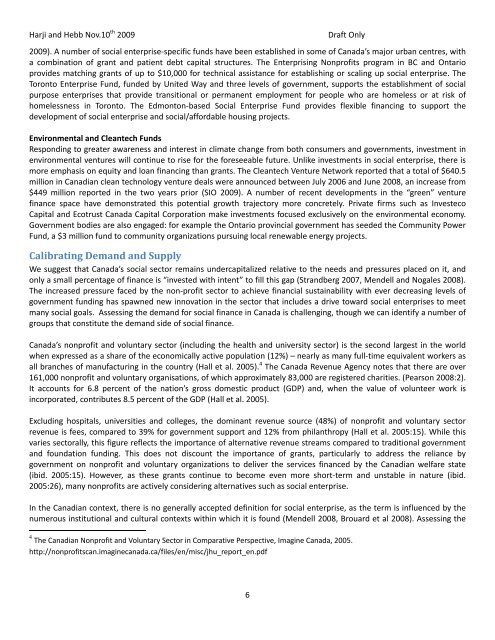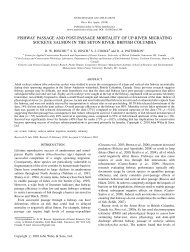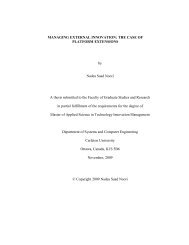The Quest for Blended Value Returns: Investor Perspectives on ...
The Quest for Blended Value Returns: Investor Perspectives on ...
The Quest for Blended Value Returns: Investor Perspectives on ...
Create successful ePaper yourself
Turn your PDF publications into a flip-book with our unique Google optimized e-Paper software.
Harji and Hebb Nov.10 th 2009<br />
Draft Only<br />
2009). A number of social enterprise‐specific funds have been established in some of Canada’s major urban centres, with<br />
a combinati<strong>on</strong> of grant and patient debt capital structures. <str<strong>on</strong>g>The</str<strong>on</strong>g> Enterprising N<strong>on</strong>profits program in BC and Ontario<br />
provides matching grants of up to $10,000 <str<strong>on</strong>g>for</str<strong>on</strong>g> technical assistance <str<strong>on</strong>g>for</str<strong>on</strong>g> establishing or scaling up social enterprise. <str<strong>on</strong>g>The</str<strong>on</strong>g><br />
Tor<strong>on</strong>to Enterprise Fund, funded by United Way and three levels of government, supports the establishment of social<br />
purpose enterprises that provide transiti<strong>on</strong>al or permanent employment <str<strong>on</strong>g>for</str<strong>on</strong>g> people who are homeless or at risk of<br />
homelessness in Tor<strong>on</strong>to. <str<strong>on</strong>g>The</str<strong>on</strong>g> Edm<strong>on</strong>t<strong>on</strong>‐based Social Enterprise Fund provides flexible financing to support the<br />
development of social enterprise and social/af<str<strong>on</strong>g>for</str<strong>on</strong>g>dable housing projects.<br />
Envir<strong>on</strong>mental and Cleantech Funds<br />
Resp<strong>on</strong>ding to greater awareness and interest in climate change from both c<strong>on</strong>sumers and governments, investment in<br />
envir<strong>on</strong>mental ventures will c<strong>on</strong>tinue to rise <str<strong>on</strong>g>for</str<strong>on</strong>g> the <str<strong>on</strong>g>for</str<strong>on</strong>g>eseeable future. Unlike investments in social enterprise, there is<br />
more emphasis <strong>on</strong> equity and loan financing than grants. <str<strong>on</strong>g>The</str<strong>on</strong>g> Cleantech Venture Network reported that a total of $640.5<br />
milli<strong>on</strong> in Canadian clean technology venture deals were announced between July 2006 and June 2008, an increase from<br />
$449 milli<strong>on</strong> reported in the two years prior (SIO 2009). A number of recent developments in the “green” venture<br />
finance space have dem<strong>on</strong>strated this potential growth trajectory more c<strong>on</strong>cretely. Private firms such as Investeco<br />
Capital and Ecotrust Canada Capital Corporati<strong>on</strong> make investments focused exclusively <strong>on</strong> the envir<strong>on</strong>mental ec<strong>on</strong>omy.<br />
Government bodies are also engaged: <str<strong>on</strong>g>for</str<strong>on</strong>g> example the Ontario provincial government has seeded the Community Power<br />
Fund, a $3 milli<strong>on</strong> fund to community organizati<strong>on</strong>s pursuing local renewable energy projects.<br />
Calibrating Demand and Supply<br />
We suggest that Canada’s social sector remains undercapitalized relative to the needs and pressures placed <strong>on</strong> it, and<br />
<strong>on</strong>ly a small percentage of finance is “invested with intent” to fill this gap (Strandberg 2007, Mendell and Nogales 2008).<br />
<str<strong>on</strong>g>The</str<strong>on</strong>g> increased pressure faced by the n<strong>on</strong>‐profit sector to achieve financial sustainability with ever decreasing levels of<br />
government funding has spawned new innovati<strong>on</strong> in the sector that includes a drive toward social enterprises to meet<br />
many social goals. Assessing the demand <str<strong>on</strong>g>for</str<strong>on</strong>g> social finance in Canada is challenging, though we can identify a number of<br />
groups that c<strong>on</strong>stitute the demand side of social finance.<br />
Canada’s n<strong>on</strong>profit and voluntary sector (including the health and university sector) is the sec<strong>on</strong>d largest in the world<br />
when expressed as a share of the ec<strong>on</strong>omically active populati<strong>on</strong> (12%) – nearly as many full‐time equivalent workers as<br />
all branches of manufacturing in the country (Hall et al. 2005). 4 <str<strong>on</strong>g>The</str<strong>on</strong>g> Canada Revenue Agency notes that there are over<br />
161,000 n<strong>on</strong>profit and voluntary organisati<strong>on</strong>s, of which approximately 83,000 are registered charities. (Pears<strong>on</strong> 2008:2).<br />
It accounts <str<strong>on</strong>g>for</str<strong>on</strong>g> 6.8 percent of the nati<strong>on</strong>’s gross domestic product (GDP) and, when the value of volunteer work is<br />
incorporated, c<strong>on</strong>tributes 8.5 percent of the GDP (Hall et al. 2005).<br />
Excluding hospitals, universities and colleges, the dominant revenue source (48%) of n<strong>on</strong>profit and voluntary sector<br />
revenue is fees, compared to 39% <str<strong>on</strong>g>for</str<strong>on</strong>g> government support and 12% from philanthropy (Hall et al. 2005:15). While this<br />
varies sectorally, this figure reflects the importance of alternative revenue streams compared to traditi<strong>on</strong>al government<br />
and foundati<strong>on</strong> funding. This does not discount the importance of grants, particularly to address the reliance by<br />
government <strong>on</strong> n<strong>on</strong>profit and voluntary organizati<strong>on</strong>s to deliver the services financed by the Canadian welfare state<br />
(ibid. 2005:15). However, as these grants c<strong>on</strong>tinue to become even more short‐term and unstable in nature (ibid.<br />
2005:26), many n<strong>on</strong>profits are actively c<strong>on</strong>sidering alternatives such as social enterprise.<br />
In the Canadian c<strong>on</strong>text, there is no generally accepted definiti<strong>on</strong> <str<strong>on</strong>g>for</str<strong>on</strong>g> social enterprise, as the term is influenced by the<br />
numerous instituti<strong>on</strong>al and cultural c<strong>on</strong>texts within which it is found (Mendell 2008, Brouard et al 2008). Assessing the<br />
4 <str<strong>on</strong>g>The</str<strong>on</strong>g> Canadian N<strong>on</strong>profit and Voluntary Sector in Comparative Perspective, Imagine Canada, 2005.<br />
http://n<strong>on</strong>profitscan.imaginecanada.ca/files/en/misc/jhu_report_en.pdf<br />
6
















